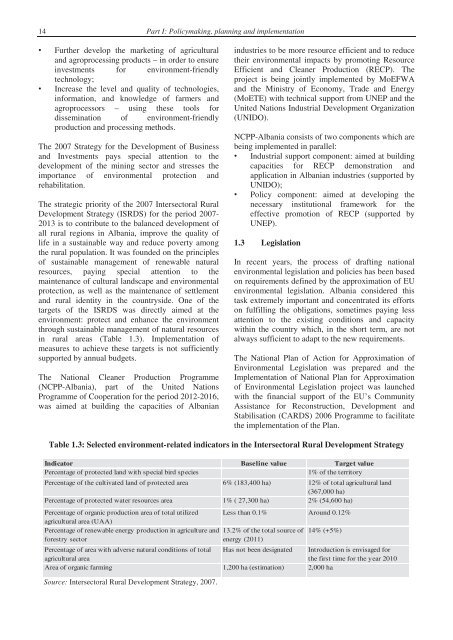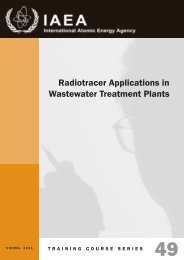Second Environmental Performance Review of Albania
Second Environmental Performance Review of Albania
Second Environmental Performance Review of Albania
Create successful ePaper yourself
Turn your PDF publications into a flip-book with our unique Google optimized e-Paper software.
14 Part I: Policymaking, planning and implementation• Further develop the marketing <strong>of</strong> agriculturaland agroprocessing products – in order to ensureinvestments for environment-friendlytechnology;• Increase the level and quality <strong>of</strong> technologies,information, and knowledge <strong>of</strong> farmers andagroprocessors – using these tools fordissemination <strong>of</strong> environment-friendlyproduction and processing methods.The 2007 Strategy for the Development <strong>of</strong> Businessand Investments pays special attention to thedevelopment <strong>of</strong> the mining sector and stresses theimportance <strong>of</strong> environmental protection andrehabilitation.The strategic priority <strong>of</strong> the 2007 Intersectoral RuralDevelopment Strategy (ISRDS) for the period 20072013 is to contribute to the balanced development <strong>of</strong>all rural regions in <strong>Albania</strong>, improve the quality <strong>of</strong>life in a sustainable way and reduce poverty amongthe rural population. It was founded on the principles<strong>of</strong> sustainable management <strong>of</strong> renewable naturalresources, paying special attention to themaintenance <strong>of</strong> cultural landscape and environmentalprotection, as well as the maintenance <strong>of</strong> settlementand rural identity in the countryside. One <strong>of</strong> thetargets <strong>of</strong> the ISRDS was directly aimed at theenvironment: protect and enhance the environmentthrough sustainable management <strong>of</strong> natural resourcesin rural areas (Table 1.3). Implementation <strong>of</strong>measures to achieve these targets is not sufficientlysupported by annual budgets.The National Cleaner Production Programme(NCPP-<strong>Albania</strong>), part <strong>of</strong> the United NationsProgramme <strong>of</strong> Cooperation for the period 2012-2016,was aimed at building the capacities <strong>of</strong> <strong>Albania</strong>nindustries to be more resource efficient and to reducetheir environmental impacts by promoting ResourceEfficient and Cleaner Production (RECP). Theproject is being jointly implemented by MoEFWAand the Ministry <strong>of</strong> Economy, Trade and Energy(MoETE) with technical support from UNEP and theUnited Nations Industrial Development Organization(UNIDO).NCPP-<strong>Albania</strong> consists <strong>of</strong> two components which arebeing implemented in parallel:• Industrial support component: aimed at buildingcapacities for RECP demonstration andapplication in <strong>Albania</strong>n industries (supported byUNIDO);• Policy component: aimed at developing thenecessary institutional framework for theeffective promotion <strong>of</strong> RECP (supported byUNEP).1.3 LegislationIn recent years, the process <strong>of</strong> drafting nationalenvironmental legislation and policies has been basedon requirements defined by the approximation <strong>of</strong> EUenvironmental legislation. <strong>Albania</strong> considered thistask extremely important and concentrated its effortson fulfilling the obligations, sometimes paying lessattention to the existing conditions and capacitywithin the country which, in the short term, are notalways sufficient to adapt to the new requirements.The National Plan <strong>of</strong> Action for Approximation <strong>of</strong><strong>Environmental</strong> Legislation was prepared and theImplementation <strong>of</strong> National Plan for Approximation<strong>of</strong> <strong>Environmental</strong> Legislation project was launchedwith the financial support <strong>of</strong> the EU’s CommunityAssistance for Reconstruction, Development andStabilisation (CARDS) 2006 Programme to facilitatethe implementation <strong>of</strong> the Plan.Table 1.3: Selected environment-related indicators in the Intersectoral Rural Development StrategyIndicatorPercentage <strong>of</strong> protected land with special bird speciesPercentage <strong>of</strong> the cultivated land <strong>of</strong> protected areaPercentage <strong>of</strong> protected water resources areaBaseline value6% (183,400 ha)1% ( 27,300 ha)Target value1% <strong>of</strong> the territory12% <strong>of</strong> total agricultural land(367,000 ha)2% (54,600 ha)Percentage <strong>of</strong> organic production area <strong>of</strong> total utilized Less than 0.1% Around 0.12%agricultural area (UAA)Percentage <strong>of</strong> renewable energy production in agriculture and 13.2% <strong>of</strong> the total source <strong>of</strong> 14% (+5%)forestry sector energy (2011)Percentage <strong>of</strong> area with adverse natural conditions <strong>of</strong> total Has not been designated Introduction is envisaged foragricultural area the first time for the year 2010Area <strong>of</strong> organic farming 1,200 ha (estimation) 2,000 haSource: Intersectoral Rural Development Strategy, 2007.
















